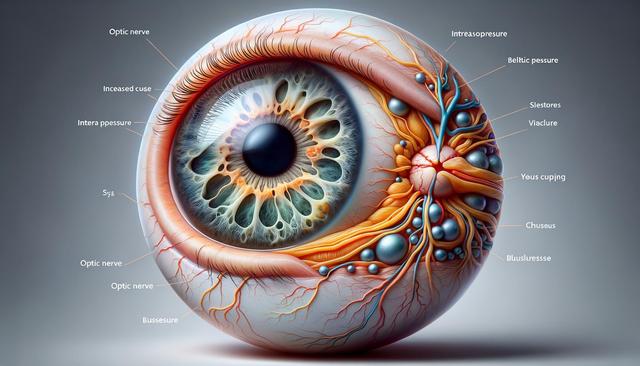What Is Glaucoma?
Glaucoma is a group of eye conditions that damage the optic nerve, a vital component responsible for transmitting visual information from the eye to the brain. This damage is often related to elevated intraocular pressure (IOP), although glaucoma can sometimes occur even when eye pressure is normal. The condition is progressive and, if left untreated, can lead to irreversible vision loss. There are several types of glaucoma, with the most common being open-angle glaucoma and angle-closure glaucoma. Each type progresses differently, but both pose serious threats to vision if not properly managed.
It’s important to note that glaucoma is one of the leading causes of blindness worldwide. Because it often begins without noticeable symptoms, it is frequently referred to as the “silent thief of sight.” Regular eye exams are essential for early detection, especially for those at higher risk, including individuals over 60, those with a family history of the disease, and people with certain medical conditions like diabetes or hypertension.
Common Signs and Symptoms
Since glaucoma often progresses without noticeable symptoms in its early stages, many people remain unaware they have it until significant vision loss has occurred. However, as the condition advances, some signs may begin to emerge. Recognizing these can be crucial for early intervention and vision preservation.
Symptoms may include:
- Gradual loss of peripheral (side) vision
- Tunnel vision in advanced stages
- Severe eye pain (in acute cases like angle-closure glaucoma)
- Blurred vision
- Halos around lights
- Redness in the eye
- Nausea and vomiting (accompanying eye pain)
Open-angle glaucoma typically has no early warning signs, which makes routine screening especially important. In contrast, angle-closure glaucoma may present more suddenly and dramatically, requiring immediate medical attention. Understanding these differences can help individuals know when to seek urgent care versus routine monitoring.
Key Causes and Risk Factors
Glaucoma can develop due to a variety of causes, but the most significant is increased intraocular pressure. This pressure buildup occurs when the eye’s drainage system becomes impaired, preventing fluid from exiting the eye efficiently. Over time, this pressure damages the optic nerve.
Several factors can increase the risk of developing glaucoma:
- Age: People over 60 are at higher risk
- Genetics: A family history of glaucoma increases the likelihood
- Ethnicity: African, Asian, and Hispanic populations are more susceptible
- Medical conditions: Diabetes, high blood pressure, and heart disease can contribute
- Eye conditions: Severe eye injuries, thin corneas, or high myopia (nearsightedness)
- Prolonged use of corticosteroid medications
While some risk factors like age and genetics cannot be changed, others can be managed through lifestyle and medical care. Understanding these causes is a critical step toward prevention and early detection.
Diagnostic Methods and Monitoring
Because glaucoma can develop without symptoms, regular eye exams are the most effective way to detect it early. Eye care professionals use several techniques to diagnose and monitor glaucoma, which allows for timely treatment and helps prevent further vision loss.
Common diagnostic tools include:
- Tonometry: Measures intraocular pressure
- Ophthalmoscopy: Examines the optic nerve for damage
- Perimetry: Tests the visual field to identify vision loss
- Gonioscopy: Checks the drainage angle of the eye
- Pachymetry: Measures corneal thickness
These tests help determine not only the presence of glaucoma but also its severity and progression. Patients diagnosed with glaucoma may undergo these exams regularly to assess treatment effectiveness and monitor changes over time.
Treatment Options and Management
Although glaucoma cannot be cured, its progression can be slowed or halted with appropriate treatment. The primary goal of treatment is to reduce intraocular pressure, which helps protect the optic nerve from further damage.
Treatment options include:
- Prescription eye drops that reduce fluid production or increase drainage
- Oral medications to lower eye pressure
- Laser therapy, such as selective laser trabeculoplasty (SLT), which improves fluid drainage
- Surgical procedures to create new drainage pathways or implant drainage devices
Choosing the right treatment depends on the type of glaucoma, the severity of the disease, and the patient’s overall health. Regular follow-ups are essential to adjust treatments as needed and ensure eye pressure remains within a safe range. Many individuals benefit from a combination of medication and laser procedures to manage their condition effectively.
Conclusion: Staying Proactive with Eye Health
Glaucoma is a serious eye condition that often progresses silently, making early detection and consistent monitoring crucial. By understanding the signs, causes, and available treatments, individuals can take proactive steps to preserve their vision. Regular eye exams, especially for those in high-risk groups, remain the most effective tool in identifying glaucoma early. While the disease cannot be reversed, timely intervention can significantly reduce the risk of severe vision loss and improve quality of life. Staying informed and vigilant is key to protecting your eye health for the long term.


